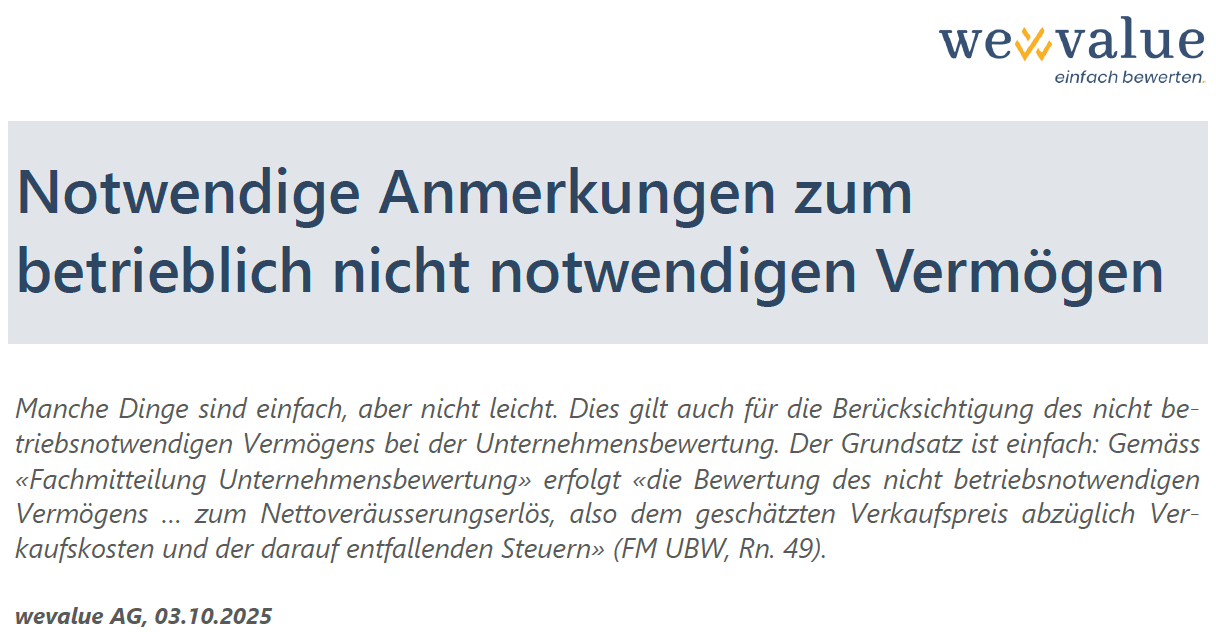Necessary comments on assets not required for business operations

Some things are simple, but not easy. This also applies to the consideration of non-operating assets in company valuations. The principle is simple: according to the “Technical Notice on Company Valuation,” “the valuation of non-operating assets … is based on the net proceeds of sale, i.e., the estimated sale price less selling costs and applicable taxes” (FM UBW, margin note 49).
Classic example or gray area?
In practice, it is not always easy to distinguish between assets that are not necessary for business operations. While works of art, yachts, and fine spirits are easy to classify, the situation becomes more complicated when it comes to rented real estate, securities, and liquidity.
The paradox: necessary but non-operational assets
In this context, little attention is paid to the fact that there are also necessary non-operating assets. For example, the purchase or sale of a sole proprietorship is by nature always an asset deal. Not all assets and liabilities can be transferred without further ado. For example, the sale of accounts receivable and accounts payable, bank balances and liabilities, current leasing and rental agreements, etc. is generally only legally possible with the consent of the relevant counterparties. This makes the transaction cumbersome, lengthy, and, above all, public. As a result, the aforementioned assets and liabilities often remain with the seller and, in effect, only fixed assets and inventories are sold.
The “empty battery” in DCF valuation
When performing a DCF valuation, it is important to ensure that the assets and liabilities retained for legal reasons are an economically necessary component of the integrated planning and the enterprise value: the company is valued “loaded” with accounts receivable, accounts payable, and liquidity, but in reality the battery is empty. Correctly, these necessary, non-operating assets reduce the enterprise value, as this gap (in the case of a positive balance) must be closed by the acquirer.
Distribution potential as a valuation trap
One further note on the valuation of assets required for operations in the case of corporations. Separate valuation assumes that these assets must also “flow” to the owners, which in the case of corporations can only take the form of a dividend. To this end, sufficient distributable equity must be available after a (hypothetical) sale.
Since only the profit after operating taxes is available after a (hypothetical) sale, not only the market values are relevant, but also the book values, in order to be able to determine the operating taxes attributable to the capital gain, the effective increase in equity and thus the distribution potential.
If the distribution is possible in terms of liquidity but not legally permissible (in other words, the money is there, but you cannot get it out of the company…), an assumption must be made about the use of the fictitious proceeds from the sale. The obvious choice is the “capital value-neutral reinvestment” assumed in distribution planning. In other words, the investment of the funds is assumed to be at the cost of capital. With this assumption (which, however, should also be explicitly stated in the expert opinion), a fictitious distribution of the proceeds of sale after taxes can be modeled even if the capital base is too thin.
Whether and to what extent personal taxes on these fictitious distributions are taken into account is ultimately a matter for negotiation. Swiss valuation practice does not take personal taxes into account. Whether this can and should be taken into account in the discussion about the price is another question.

